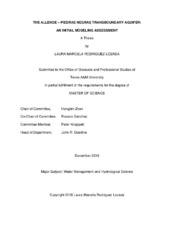| dc.description.abstract | The Allende-Piedras Negras (APN) aquifer is located between the state of Texas (USA) and the state of Coahuila (Mexico). The Rio Grande/Rio Bravo crosses the aquifer acting as a natural and political divide between both countries. Besides, the area had a gap identified by previous studies where the absence of an aquifer assignment was notorious; also, these studies were developed at the local level but not covering the entire gap. The main purpose of this work is generating a hydrogeological model to perform a detailed analysis of the APN aquifer.
To generate a hydrogeological model, geological information was collected to correlate the geological units on both sides of the border and define the physical dimensions of the aquifer. Precipitation, river discharge, and evapotranspiration data were assembled from field data and remote sensors; hydraulic parameters such as permeability, hydraulic conductivity and specific storage were obtained from previous studies performed in the area. For the Texas side, water well information was downloaded from the Texas Water Development Board website. For the Mexican side, water well information was provided by the Public Registry of Water Rights (Registro Publico de Derechos del Agua), Lesser and Associates and the United States Environmental Protection Agency (EPA). The software Visual MODFLOW was used to develop the hydrogeological model, which verified the hydraulic connections of the transboundary aquifer system. At last, a water budget analysis was performed to determine the groundwater amounts coming from both countries into the Rio Grande/Rio Bravo system.
The hydrogeological model quantified an accumulated drawdown of 0.76 m in 17 years. Also, the flow convergence zone located below the Rio Grande/Rio Bravo, shifted mainly to USA due to the high pumping rates of the wells near the river. This shifting allows the categorization of the APN aquifer as a “transboundary groundwater flow” system, which would influence water management decisions across the USA-Mexico border. Lastly, most of the groundwater discharged into the Rio Grande/Rio Bravo comes from the Mexican side due to steeper terrain slopes south of the border.
The methodology followed in this study to perform a detailed analysis of the Allende-Piedras Negras aquifer could also be applied in other aquifers that straddle the border. The expected impact of this study is that it will motivate future modeling studies on other poorly studied aquifers along the border between USA-Mexico and provide the first assessments for potential joint aquifer management in the region. | en |


